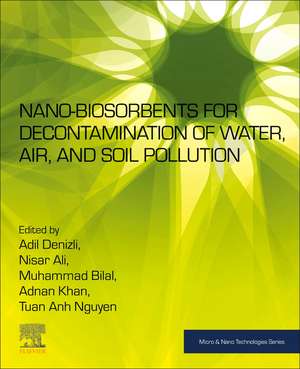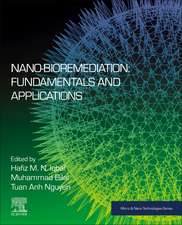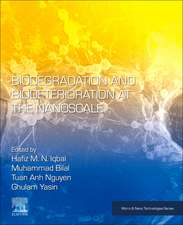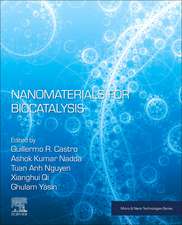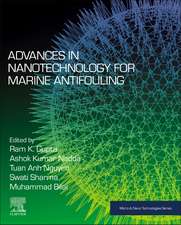Nano-biosorbents for Decontamination of Water, Air, and Soil Pollution: Micro and Nano Technologies
Editat de Adil Denizli, Nisar Ali, Muhammad Bilal, Adnan Khan, Tuan Anh Nguyenen Limba Engleză Paperback – 7 feb 2022
- Highlights the environmental applications of chitosan-based, cellulose-based and polymer-based nanoscale biosorbents
- Explains the advantages of using different types of nanobiosorbents for soil, water and air purification applications
- Assesses the challenges associated with manufacturing nanobiosorbents cheaply and on an industrial scale
Din seria Micro and Nano Technologies
- 20%
 Preț: 768.40 lei
Preț: 768.40 lei - 9%
 Preț: 987.08 lei
Preț: 987.08 lei -
 Preț: 550.24 lei
Preț: 550.24 lei - 9%
 Preț: 1043.14 lei
Preț: 1043.14 lei - 24%
 Preț: 1048.26 lei
Preț: 1048.26 lei - 23%
 Preț: 1100.40 lei
Preț: 1100.40 lei - 28%
 Preț: 738.06 lei
Preț: 738.06 lei - 23%
 Preț: 692.90 lei
Preț: 692.90 lei - 28%
 Preț: 571.91 lei
Preț: 571.91 lei - 9%
 Preț: 733.82 lei
Preț: 733.82 lei - 28%
 Preț: 825.39 lei
Preț: 825.39 lei -
 Preț: 222.86 lei
Preț: 222.86 lei - 24%
 Preț: 869.31 lei
Preț: 869.31 lei - 23%
 Preț: 734.77 lei
Preț: 734.77 lei - 28%
 Preț: 811.47 lei
Preț: 811.47 lei - 16%
 Preț: 766.36 lei
Preț: 766.36 lei - 28%
 Preț: 934.58 lei
Preț: 934.58 lei - 23%
 Preț: 732.00 lei
Preț: 732.00 lei - 23%
 Preț: 810.11 lei
Preț: 810.11 lei - 23%
 Preț: 937.71 lei
Preț: 937.71 lei - 23%
 Preț: 603.19 lei
Preț: 603.19 lei - 18%
 Preț: 222.37 lei
Preț: 222.37 lei - 18%
 Preț: 653.54 lei
Preț: 653.54 lei - 19%
 Preț: 659.03 lei
Preț: 659.03 lei - 9%
 Preț: 1016.51 lei
Preț: 1016.51 lei - 29%
 Preț: 989.78 lei
Preț: 989.78 lei - 28%
 Preț: 737.80 lei
Preț: 737.80 lei - 9%
 Preț: 848.26 lei
Preț: 848.26 lei - 9%
 Preț: 736.59 lei
Preț: 736.59 lei - 29%
 Preț: 803.90 lei
Preț: 803.90 lei - 9%
 Preț: 963.06 lei
Preț: 963.06 lei - 28%
 Preț: 644.55 lei
Preț: 644.55 lei - 23%
 Preț: 813.30 lei
Preț: 813.30 lei - 23%
 Preț: 608.83 lei
Preț: 608.83 lei - 9%
 Preț: 683.99 lei
Preț: 683.99 lei - 9%
 Preț: 792.39 lei
Preț: 792.39 lei - 28%
 Preț: 817.45 lei
Preț: 817.45 lei - 23%
 Preț: 909.30 lei
Preț: 909.30 lei - 32%
 Preț: 528.10 lei
Preț: 528.10 lei - 28%
 Preț: 698.33 lei
Preț: 698.33 lei - 23%
 Preț: 692.32 lei
Preț: 692.32 lei - 9%
 Preț: 571.98 lei
Preț: 571.98 lei - 23%
 Preț: 609.24 lei
Preț: 609.24 lei - 16%
 Preț: 290.93 lei
Preț: 290.93 lei - 28%
 Preț: 816.40 lei
Preț: 816.40 lei - 9%
 Preț: 811.32 lei
Preț: 811.32 lei - 21%
 Preț: 292.28 lei
Preț: 292.28 lei - 9%
 Preț: 807.78 lei
Preț: 807.78 lei - 5%
 Preț: 637.68 lei
Preț: 637.68 lei - 34%
 Preț: 189.43 lei
Preț: 189.43 lei
Preț: 1053.20 lei
Preț vechi: 1374.91 lei
-23% Nou
Puncte Express: 1580
Preț estimativ în valută:
201.55€ • 218.86$ • 169.31£
201.55€ • 218.86$ • 169.31£
Carte tipărită la comandă
Livrare economică 16-30 aprilie
Preluare comenzi: 021 569.72.76
Specificații
ISBN-13: 9780323909129
ISBN-10: 0323909124
Pagini: 646
Ilustrații: 50 illustrations (50 in full color)
Dimensiuni: 191 x 235 mm
Greutate: 1.09 kg
Editura: ELSEVIER SCIENCE
Seria Micro and Nano Technologies
ISBN-10: 0323909124
Pagini: 646
Ilustrații: 50 illustrations (50 in full color)
Dimensiuni: 191 x 235 mm
Greutate: 1.09 kg
Editura: ELSEVIER SCIENCE
Seria Micro and Nano Technologies
Cuprins
Section I: Basics principles
1. Nano-biosorbents for contaminant removal: An introduction
2. Introduction to nano-biosorbents
3. Nanobiosorbents: Basic principles, synthesis, and application for contaminants removal
4. Methods for the synthesis of nanobiosorbents for the contaminant removal
5. An insight into the potential contaminants, their effects, and removal means
6. Advantages of nanoadsorbents, biosorbents, and nanobiosorbents for contaminant removal
7. Nanomaterials for removal of heavy metals from wastewater
8. Nanosorbents for heavy metals removal
9. Non-toxic nature of nano-biosorbents as a positive approach toward green environment
10. Nanoadsorbents for environmental remediation of polluting agents
Section II: Cellulose-based nanobiosorbents for decontamination of environmental matrices
11. Risk assessment of nanocellulose exposure
12. Cellulose-based nanobiosorbents: An insight
13. Synthesis and properties of cellulosebased nanobiosorbents
14. Introduction to cellulose-based nanobiosorbents
15. Cellulose composites as nanobiosorbents for ecological remediation
16. Modification and derivatization of cellulose-based nanobiosorbents and their utilization in environmental remediation
17. Cellulose-based nano-biosorbents in water purification
Section III: Chitosan-based nanobiosorbents for deterioration of environmental matrices
18. Toxic metals adsorption from water using chitosan nanoderivatives
19. Toxicological impact and adsorptive removal of triclosan from water bodies using chitosan and carbon-based nano-architectures
Section IV: Multifarious biopolymers as nanobiosorbents for decontamination of environmental matrices
20. Citrus waste-based sorbent for wastewater treatment
21. Alginate-based nanobiosorbents for bioremediation of environmental pollutants
22. Synthesis of novel nanobioadsorbent for the effective removal of Pb2+ and Zn2+ ions—Adsorption, equilibrium, modeling, and optimization studies
23. Nanocrystalline NiO powder: Synthesis, characterization and emerging applications
24. Attraction to adsorption: Preparation methods and performance of novel magnetic biochars for water and wastewater treatment
25. Biomass-derived nanocomposites: A critical evaluation of their performance toward the capture of inorganic pollutants
26. Magnetic nanomaterials-based biosorbents
1. Nano-biosorbents for contaminant removal: An introduction
2. Introduction to nano-biosorbents
3. Nanobiosorbents: Basic principles, synthesis, and application for contaminants removal
4. Methods for the synthesis of nanobiosorbents for the contaminant removal
5. An insight into the potential contaminants, their effects, and removal means
6. Advantages of nanoadsorbents, biosorbents, and nanobiosorbents for contaminant removal
7. Nanomaterials for removal of heavy metals from wastewater
8. Nanosorbents for heavy metals removal
9. Non-toxic nature of nano-biosorbents as a positive approach toward green environment
10. Nanoadsorbents for environmental remediation of polluting agents
Section II: Cellulose-based nanobiosorbents for decontamination of environmental matrices
11. Risk assessment of nanocellulose exposure
12. Cellulose-based nanobiosorbents: An insight
13. Synthesis and properties of cellulosebased nanobiosorbents
14. Introduction to cellulose-based nanobiosorbents
15. Cellulose composites as nanobiosorbents for ecological remediation
16. Modification and derivatization of cellulose-based nanobiosorbents and their utilization in environmental remediation
17. Cellulose-based nano-biosorbents in water purification
Section III: Chitosan-based nanobiosorbents for deterioration of environmental matrices
18. Toxic metals adsorption from water using chitosan nanoderivatives
19. Toxicological impact and adsorptive removal of triclosan from water bodies using chitosan and carbon-based nano-architectures
Section IV: Multifarious biopolymers as nanobiosorbents for decontamination of environmental matrices
20. Citrus waste-based sorbent for wastewater treatment
21. Alginate-based nanobiosorbents for bioremediation of environmental pollutants
22. Synthesis of novel nanobioadsorbent for the effective removal of Pb2+ and Zn2+ ions—Adsorption, equilibrium, modeling, and optimization studies
23. Nanocrystalline NiO powder: Synthesis, characterization and emerging applications
24. Attraction to adsorption: Preparation methods and performance of novel magnetic biochars for water and wastewater treatment
25. Biomass-derived nanocomposites: A critical evaluation of their performance toward the capture of inorganic pollutants
26. Magnetic nanomaterials-based biosorbents
